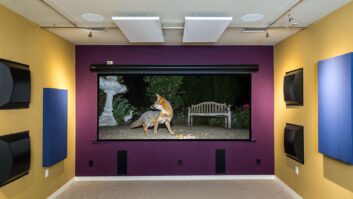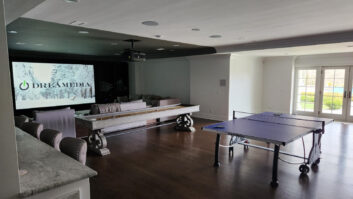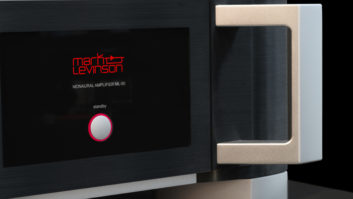When it comes to home theater acoustics, ignorance is certainly not bliss. More now than ever, custom installers are faced with the task of bridging a living space with the technical requirements needed to make it function as a full-fledged entertainment venue while maintaining a sense of home. For custom installers, that singular challenge is caught up in such a web of factorsincluding a lack of acoustical knowledge and just plain short sightednessthat many of them will simply ignore it as an option for their clients.
This is probably the field in which installation companies fail the most, said Mark Ontiveros, president of Tustin, California, home cinema dealership, Audio Images. In other words, they put equipment sales and education on equipment far above room acoustics and proper acoustical training, when actually it should be the reverse. No matter how much money they put into the equipment, it wont sound any better the higher-end you go unless the room acoustics and engineering are correct. And there is a basic foundation you have to have for that. It is where our trade has been less educated and quite honestly, failing.
To be fair, the science of acoustics, at least on paper, can seem confusing and intimidating. But as the home theater segment continues to grow and experience fierce competition among manufacturers and sales outlets, installers need to find ways to pull up their grades and distinguish themselves from the pack. To light a fire under the feet of those who resist placing acoustics high on their to-do list, Ontiveros cites the diminishing returns the A/V industry is currently suffering due to falling prices of equipment thanks to the Internet and price wars, and recommends that installers take this moment in time to shine.
I know it is complicated and complex, but there are some great people out there teaching, Ontiveros said. Otherwise, what prevents potential clients from going to the [big box outlets] of America and just getting a loud TV? For our clients, this is where we add our experience and expertise. We have to add value as an industry or we will be out of business as an industry.
If the theories behind bass traps, diffusion, and absorption make your head spin, consulting an experienced acoustician might be best. Anthony Grimani, a well-respected acoustical designer and head of California-based PMI Industries, recommends enlisting the help of a professional, not only to do a pitch-perfect installation job, but also to give the client peace of mind about their expensive addition.
The help ends up being a perceived good to the client, Grimani said. When you bring a third party who is an [engineer], a party who just wants to make sure things work well, it gives the client comfort. I have observed that the fear factor the client should have after plumping down $200,000 to $300,000 is alleviated when a contractor brings in an acoustician, because they say, Cool, I have this independent third party who is going to vouch for the quality of this installation. I think that is an important consideration.
Typically, acoustically treating a home theater averages out to about 10 percent of the overall projects budget. No matter the cost of the overall home theater A/V system installed, however, this will always be a drop in the bucket when weighed against the benefits of having an expensive system sound as good as its worth. For Grimani, it is almost criminal not to go into a high-end home theater without first running a full diagnostic on how the it will eventually sound.
I too often see these expensive systems in which the engineering is just creating a list of products and putting them in, Grimani said. I have been in front of high-end systems that are just completely misbehaving, and ultimately the customer didnt get close to their moneys worth.
Also critical to maximizing the acoustical potential of any home theater is the room in which it will be housed. This requires careful, thoughtful planning to determine if the location chosen for the theater is best and just what kind of acoustical accoutrements will work well within the rooms dimensions.
In any A/V system the room is one big part of the equipment; it becomes part of the system, Grimani said. From the point of view of what you are seeing and hearing, the room interacts with the speakers and the listener, adding to the sound. We want to hear the soundtrack and the music, and the room is adding to that.
This means, according to Grimani, a judicious and careful acoustic design for the room, using both computer-based models and acoustic techniques like auralization, that take into account room dimensions and location to issue predictions and calculation that will comprise the custom acoustical treatment.
Acoustics manufacturer, Auralex is one of the few in its field to offer this kind of service. The company, with its dealers, provides forms on its website, where room dimensions, speakers, layout, and even furniture can be keyed in.
Well do the service and then in a couple of days turn it back to [the dealers], explained Tracy Chandler, Auralexs director of sales and marketing. Now they will have exactly what the room needs to have proper acoustics, because we use software modeling to design the acoustics for that particular space.
Kinetic Noise Control, which produces noise control materials and vibration isolation mounts, has a similar hands-on network with its dealers. To provide these services for residential projects such as home theaters, we developed a Representative/audio video dealer network, explained Larry Holben, the companys vice president of sales. The representatives responsibility is to distribute all promotional and new product information to the A/V dealers. The dealer introduces our products and services to the customer or builder. After there is some discussion about the construction of a dedicated home theater/media room, we collect all required information from the architect, dealer or builder.
Depending on the complexity of the project, an acoustical consultant may be required. If none are currently involved, we can make recommendations of consultants specializing in the design of home theaters. At this point KNC provides AutoCad drawings showing recommended product selection and positioning. Products recommended at this stage are room structure isolation products such as floating floors, wall isolation, and suspended ceiling isolation.
Auralex has a three-tier system for its acoustic products based on the elasticity of a projects budget and its aesthetic requirements. Because all three solutions are acoustically the same, the deciding factor is primarily visual.
Aurelex is not alone in paying attention to the visual aspects of acoustics. For most acoustics manufacturers and dealers, aesthetics rank as among one of the key selling points for their lines.
The problem for most dealers in employing these things is visual, said Jerry LaMay, acoustical design and technical direct for Quest Acoustical. Trying to get someone to put a piece of upholstery-covered fiberglass on their wall isnt the simplest sales job. With interior design, just as influential as the space itself, most manufacturers have incorporated fashionable fabrics and textures to their product lines for chameleon integration into a rooms overall design. So much of home theater depends on interior design, said Nick Colleran, Acoustic Firsts marketing director and principal. If it doesnt pass the looks good test, then it will never get to the sounds good part.
Acoustic Firsts patent-pending QuadraPyramid flat-panel diffuser caters to both the eye and ear. Installed as an exposed, offset pure middle diffuser, its Egyptian design allows for sound scattering. The company also carries the unobtrusive Sound Shim, an angled wall panel that acts as a low-frequency absorber or bass trap.
Similarly, Quest Acousticals Quest Track serves the dual purpose of providing absorption and diffusion, while allowing a room to retain its everyday function as a family room or drawing room with its range of fabric concealers.
Suede is the concealer of choice for Richmond, Virginia-based, Acoustical Solutions, which employs the fabric in its SoundSuede Wrap wall panels, bass traps, and diffusers. There are about 55 different colors to choose from so [clients] can create their own look, explained Don Strahle, marketing director for the company. And suede, being the kind of fabric it is, it more decorative look than some panels that you see that are more [suitable] in an office.
Salon Acoustics, one of Grimanis investments, takes acoustical hide-and-seek one step further by disguising acoustics behind artwork, which could be a photograph taken by the client or an expensive reprint of a famous piece of art.
The scientist in Grimani brings it back to the basics of acoustics itself and offers up his own guidelines for and excellent acoustic treatment. Regardless of the cost of the system, he recommends that absorption materials need to be thick enough to absorb well down to 200 to 300 Hertz, noting that thinner material might actually create problems by only doing half the job; absorption and diffusion should be employed in equal measures to give balance to a room; and bass absorption or bass trapping, which allows the listener to better hear the bottom end of the bass.
It is important the room is equipped with a combination of those three devices on the walls and ceilings, Grimani explained. Figuring out the right amount it is where the science of acoustician comes in.
Llanor Alleyne is managing editor of Residential Systems.







